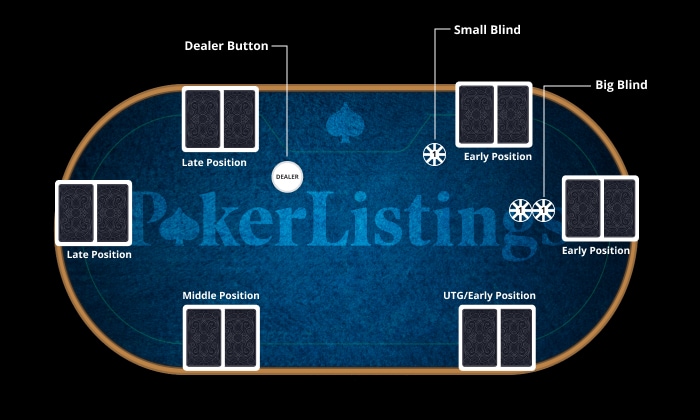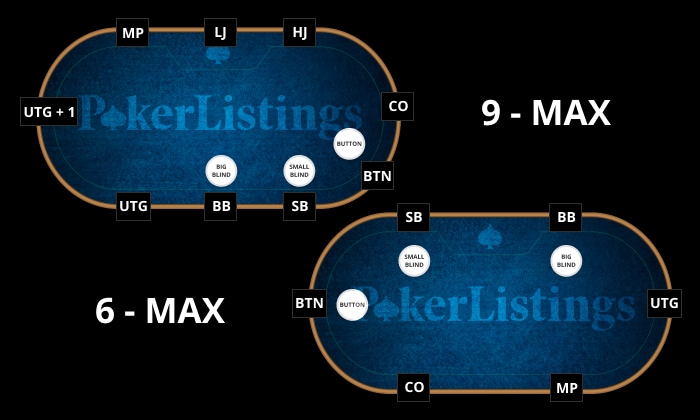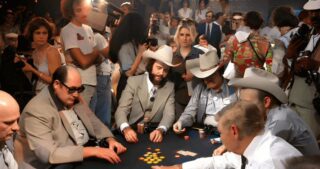- PokerListings »
- How to Play Poker »
- Poker Positions Explained
Poker Positions Explained
What Are the Positions in Poker?
Do you know all of the positions in poker? How about the value of poker positions? Besides hand rankings and bet sizing, poker also requires deep understanding of play from different positions. This guide will explain all the spots at a poker table and how you can play your position like a pro.
Besides hand rankings and how to bet, you also need to understand ranges, and the value of your holding in relation to your position at the table. In other words, making a certain move in one seat could be correct but incorrect in another.
For example, if you’re the last person to act in a hand (meaning, you’ve got “position”), raising might be a good idea. However, if you’re second to act and there are two players behind you, raising might be a bad idea. We’ll go into more detail about this later in our guide to poker positions. For now, just know that where you’re sitting on a poker table is important. Regardless of whether it’s first, third, or last, positions in poker matter.
The following lists will give you a general overview of the positions at a 9-handed table and a six-max when you play poker online.

Poker table positions 9-handed
Seat 1: Big Blind (BB) - This is the player who puts in the biggest ante aka the Big Blind. The Big Blind is last to act pre-flop but one of the first to act post-flop. Everything is built around the Big Blind.
Seat 2: Small Blind (SB) - The Small Blind is directly to the right of the Big Blind. This never changes. The Small Blind is a forced bet (ante) that’s 50% of the Big Blind. For example, if the Big Blind is $2, the Small Blind is $1. The Small Blind makes the penultimate move pre-flop but will act first post-flop.
Seat 3: The Button (BTN) - The button is regarded as the best position in a poker game. It’s situated directly to the right of the small blind. It’s the third-to-last to act pre-flop. However, the button acts last post-flop. This makes it the most powerful because you get to close the action - everyone has to act before you, which means you get more information.
Seat 4: The Cutoff (CO) - Located to the right of the button, three before the Big Blind. Although it’s not quite as powerful as the button. It’s so-called because it’s one of the last points at which you’re considered to be in a strong position at the poker table.
Seat 5: The Hijack (HJ) - This a great spot to try and steal from the cutoff and button which are both to the left of this seat. It can be a strong position in poker because you get to act late pre and post-flop.
Seat 6: The Lojack (LJ) - The lojack position in poker is directly right of the hijack. However, because it’s one of the middle table spots, it isn’t super powerful. So, you need a strong hand to make moves from here.
Seat 7: Early Position (EP) - Early position in poker is no man’s land - you don’t want to play weak hands because you’re always one of the first people to act. At a nine-handed table, Seat 7 will be the third to act. It’s located three spots to the left of the Big Blind.
Seat 8: UTG+1 - This is another early position poker players will find themselves in at the table. It’s not quite as weak as UTG, but it’s pretty close. You’re two to the left of the Big Blind, a long way from the button and you’ll be second to act pre-flop.
Seat 9: UTG - Being Under the Gun (directly left of the Big Blind) is the toughest spot, particularly pre-flop, because you act first. If either of the blinds remain active in the hand, UTG doesn’t act first post-flop. If the blinds are folded, that player acts first post-flop. Everyone gets to react to your moves which, in turn, means you’re operating with less information. So, you should only play strong hands here.
6 handed poker positions
6-max poker positions are, largely, the same as their 9-handed counterparts. However, the big difference here is that certain seats have more power because there are fewer players at the table. Because it’s all about information and the number of people to act after you’ve made a move. If there are fewer players, there is less that can happen after you’ve acted. That means you can play certain poker seat positions more aggressively in a 6-max game than you could at a 9-handed table.
- Seat 1: Big Blind (BB) - This is the same as it is in a 9-max.
- Seat 2: Small Blind (SB) - This is the same as it is in a 9-handed game.
- Seat 3: The Button (BTN) - This is the same as on a full ring table.
- Seat 4: The Cutoff (CO) - This isn’t a late position seat in 6-max like on a 9-handed table.
- Seat 5: Middle Position (MP) - This is directly to the right of UTG and two spots from the button.
- Seat 6: Under the Gun (UTG) - Always first player to act pre-flop, sitting directly left of the BB.

The Role of the Dealer Button
Why do players care about the button? Well, firstly, this is what moves the action around the table. The blinds are always to the left of the button. As the button moves in a clockwise direction, so do the blinds. This keeps the action moving and, moreover, it means everyone is given a chance to experience all the table positions in poker.
What’s more, the buttons and the blinds force action. If you weren’t under pressure to pay the blinds every so often, you’d never have to worry about your stack dwindling. Therefore, you’d only play premium hands. The button and the blinds make you play.
Finally, the button and the blinds determine everyone's table position and, in turn, different strategic considerations. As we’ve said, it’s always better to act late. When you’ve got more information at your disposal (i.e. you’ve seen what everyone else has done), it’s easier to make decisions.
Couple this with the fact you close the action on the button, and it’s easy to see why it’s the best position in poker. Basically, if you’re on the button, it’s a good place to be. Therefore, when it comes to cash game and tournament strategy, you can afford to have a wider range on the button.
What is the Best Overall Strategy for Each Position?
- Early - Tight, narrow range of hands
- Middle - Relatively tight, but add more suited connectors and weak aces to your range
- Late - Raise and call with a wider range
It’s important to understand where the cutoff is, for example. However, you have to use this to improve your game and develop a poker positions strategy. In other words, you need to have specific tactics for wherever you’re sitting. Now, it’s important to add the caveat “it depends” to everything we’re about to say. Just because the hijack position in poker focuses on raising a lot of hands, that doesn’t mean you should always be aggressive here.
Everything you do has to be based on a variety of factors. Position is one variable within a much larger set of considerations. So, if we say, “do X in these positions on a poker table”, that doesn’t mean you should follow our advice blindly. Use it as a starting point and adapt accordingly.
Early - When you’re under the gun or close, you need to adopt a tight strategy. This means playing a narrow range of hands and only entering the pot when you believe you have an advantage. This is because you have to act first - and playing out of position poker puts you at a disadvantage because you have less information to base your decisions on.
Middle - Developing a mid-position range is tricky. Playing from earlier spots with 8-6 suited is an easy fold, and from the button, you can raise. Meanwhile, from mid-position, it’s less obvious. You have to have a semi-tight range balanced with some suited connectors and weaker aces, if table dynamics allow. Otherwise you may have to adjust. Example, with an aggressive player to your left, play tighter. If the players behind you are tight, be more aggressive.
Late - Playing from here is the most fun because you can play looser and more aggressive - bet, call and raise a lot more hands. You’ll have an advantage throughout the hand which gives you more info to act on. Generally, if you’re close to or in the dealer position, you should be willing to play more hands.
Poker Positions Ranges
Based on the above strategies, we can start to create some positions hand charts. These charts should give you an idea of which hands to play in certain spots. Again, the following ranges aren’t written in stone - You should adjust based on table dynamics. However, these should give you a solid starting point:
| 9-max Table Order | Poker Open Raise Range |
| Early | Premium Pairs: (T-T sometimes), J-J, Q-Q, K-K, A-A Strong Aces: A-J suited, A-Q suited and unsuited, A-K suited and unsuited |
| Middle | All above hands, plus: T-T, 9-9, 8-8 A-J unsuited, A-T suited, K-Q suited Some suited connectors: Q-J, J-T, T-9 |
| Late | All of the above hands, plus: All pairs A-7 suited or better 8-9 and 7-8 suited |
| 6-max Table Order | Open Raise Range |
| Early | Pairs: (9-9 sometimes), T-T, J-J, Q-Q, K-K, A-A Strong Aces: A-T suited, A-J suited and unsuited, A-Q suited and unsuited, A-K suited and unsuited |
| Middle | All above hands, plus: 9-9, 8-8, 7-7 A-T unsuited, K-Q suited and unsuited, (K-J and K-T suited sometimes) Some suited and unsuited connectors: Q-J, J-T, T9, 8-9 |
| Late | All of the above hands, plus: All pairs 6-6+ A-6+ K-T+ Suited and unsuited connectors 6-7+ |
How to Play in Position in Poker
Exploiting the button or close seats is all about playing to your strengths and exploiting the weaknesses of your opponents. To put it another way, you’re playing the value of your own hands, but you’re also reacting to what other people do.
For example, if you’re on the Button with 5-6 suited and a player from middle position limps, you can take this as a sign of weakness and raise. Normally you might call a raise with this hand or fold. However, because playing later has allowed you to spot a weakness, you can try to exploit it with a hand like 5-6 suited.
At this point, you’re exploiting, instead of just playing your hand. Of course, you could hit something on the flop and that will alter your plan of action. However, the value of 5-6 suited doesn’t really matter here. That’s why position in poker is valuable and, in turn, why it pays to be more aggressive when you’re last to act.
Advantages of Playing in Position in Poker
- More Free Cards
It’s possible to take free cards when you’re last to act. Players may be afraid to bet because you have the option to raise. Therefore, they may check in the hope you’ll check or that you’ll make a small bet which they’d rather call than a raise. Either way, you get more control in a late seat and that allows you to see more free cards.
- Pot Control
In the same way you can get free cards, you can use position to control the size of the pot. If you want to check or call bets and keep the pot small, it’s much easier when you’re on the BTN playing postflop poker. If you want to raise it up and get more value/create a spot where you can bluff, it’s also easier from the button or close to.
- More Bluffing Options
Bluffing is all about information and timing. From the button or close to, you have the chance to gather a lot more information. Indeed, if you go back to our example of raising a limper with 5-6 suited, the same principle applies when you’re bluffing. If the player/s in front of you show signs of weakness, you’re in a good place to react and play aggressively with any two cards.
- Pot Odds
Playing last means you close the action on each street (except pre-flop). That means you know exactly what’s in the pot and the amount you have to call. This allows you to calculate the pot odds with 100% certainty.
For example, if there’s $10 in the pot and it’s $2 to call, you’re getting odds of 5:1. If there are people to act after you, you won’t know the pot odds for certain. Sticking with the same example, you might be getting 5:1 on a call. However, you might call and the next player to act raises. Therefore, you’ll have to put even more money into the pot to stay in the hand. This means, in effective terms, you didn’t have 5:1 pot odds.
- Having More Info on Opponent
The final point ties everything together and it’s what we’ve been saying through this guide. The later you act, the more information you’ve got at your disposal. You don’t know what cards someone is holding during a hand, but you can see what moves they’ve made. This is an advantage and the main reason you should look to be more aggressive on the button but conservative while acting first or early.
Poker Positions Summary
OK, so that’s poker positions explained and how to adjust according to your spot at the table. Just because we’ve said you should play certain hands from certain spots, that doesn’t mean that’s always true. Everything you do should be based on the players around you, the cards you’re dealt, previous actions and, finally, position. That’s as true for cash games as it is for SNGs and poker tournaments. However, if you’re going to take anything from this, always remember:
“If you’re acting early, play conservatively. If you’re acting late, play aggressively.”
Those two rules should give you a solid foundation from which to build an effective plan of action and, hopefully, play your position in a better way.
Poker Positions FAQs
-
What are the positions in poker?
In general, there is early, middle and late spots, starting from: UTG, UTG+1, lojack, hijack, CO, Button, small blind and big blind respectively. The strategy you adopt should be based on the spot you find yourself in at the table. -
What is the best seat at the poker table?
The best spot at the poker table is the button, also known as the dealer. This spot allows you to act last post-flop and, therefore, get the most information possible during the hand. -
What is the worst position in poker?
The worst table seat at the poker table is when you’re first to act. This is the player directly to the right of the big blind pre-flop. Post-flop, it is the player nearest to the left of the button. -
What is under the gun in poker?
Under the gun, (UTG) is the term used to describe the player who has to act first in a hand. Meaning the player directly to the right of the big blind pre-flop. -
What is HJ in poker?
HJ is the abbreviation for hijack position, which, at the table, is seated two spots before the button. This a great spot to try and steal from the cutoff and button which are both to the left of this seat. It can be a strong position in poker because you get to act late pre and post-flop. -
What is CO in poker?
CO is the abbreviation for the cutoff position in poker is the spot just before the button. Although it’s not quite as powerful as the button. It’s so-called because it’s one of the last points at which you’re considered to be in a strong position at the poker table. -
Why is position important in poker?
Because it allows you to gather more information about your opponents. Poker is a game of imperfection information. Therefore, the more you can get, the easier it is to make a decision. -
What is a position raise in poker?
This is when you make a bet/raise based on where you’re sitting in relation to other players. For example, if someone makes a weak bet, you may make a raise to exploit their weakness.

















